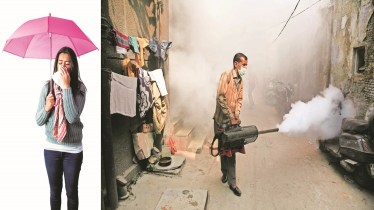As the monsoon season progresses, fresh concerns on water- and vector-borne diseases are on the rise, and with it the incidence of malaria, dengue, chikungunya and viral fever as well. During this time, say doctors, these diseases can easily be contracted due to mosquitoes festering in standing water due to the rains.
According to Dr Shalmali Inamdar, consultant, physician and adult infectious diseases, Kokilaben Dhirubhai Ambani Hospital, Mumbai, “These viral infections are particularly prevalent due to the hot and humid conditions that facilitate the spread of viruses and mosquito-borne diseases.” During this season, the doctor observes several patients with influenza and chikungunya frequenting the hospital’s outpatient department (OPD). “Compared to last year, the rise in dengue cases has been slightly delayed this time, but it is gradually appearing. We are also seeing a fair number of malaria cases. These are the predominant infections being reported during this time,” she adds.
She elaborates that several of the commonly occurring diseases during monsoon, such as dengue, malaria and chikungunya, are spread from standing water and mosquitoes.
According to the National Centre for Vector-Borne Disease Control (NCVBDC) under the Ministry of Health and Family Welfare (MoHFW), dengue cases in India have increased from 28,066 in 2010 to over 289,000 in 2023. As of March this year, India has already reported more than 16,000 cases, indicating a worrying early trend for the year. This massive and continuing rise stresses the urgency of strengthening the public health systems of the country.
Northern Indian states like Jammu & Kashmir and Himachal Pradesh have started seeing regular outbreaks, a sign that the traditional ‘dengue belt’ is expanding, as per a study published in Healthcare Radius, mapping the incidence of the mosquito-borne viral disease across the country.
The NCVBDC has separate programmes running in every state for the management of malaria, dengue and chikungunya from among water-borne diseases, as well as filaria, Kala Azar and Japanese encephalitis. Surveys are done across districts to check for symptoms of water-borne diseases, preventive measures are taken, and treatments like fogging are administered in localities where likelihood of contracting is high.
The NCVBDC has found that a total of 80 districts in the country are resistant to chloroquine, which is the drug used to prevent and treat malaria. For these districts as well as others with high incidence of the disease, the state malaria elimination programmes are adopting Artemisinin-based Combination Therapy (ACT) for prevention. ACT is considered the most effective treatment in ruling out malaria.
Of 806 districts, 163 were found to have the highest drug-resistant populations — 50 districts from Andhra Pradesh, Chhattisgarh, Jharkhand, Madhya Pradesh and Odisha; 67 districts from northeastern states, and 253 public health centres from 46 other districts showing scattered resistance to chloroquine.
As for dengue, till March alone, the country saw 12,043 cases of the disease and six deaths due to it. This was prior to the onset of the monsoon season.
Watch out for
Speaking about the common symptoms that people should be conscious of during the season, Dr Vasant C Nagvekar, director of infectious diseases, Sir HN Reliance Foundation Hospital, Mumbai, says, “Upper respiratory infection with high fever is consistent with influenza A, and fever with acute joint pains can be expected with chikungunya. Dengue comes with retro-orbital headache and severe backache, also called break bone fever.”
He goes on to say that a diagnosis is very important for such diseases as one can only then take steps to prevent the severity. “Flu in elderly and those having comorbidities can be serious if left untreated, and similarly so for malaria and leptospirosis,” he says. “Dengue and chikungunya are also viral illnesses and it is required to watch out for any complications as no specific treatment is available,” Dr Navgekar adds.
Dr Inamdar adds to the warning signs: “There are certain warning signs that require immediate medical attention. These include chest pain, breathlessness, rashes on the body, or a high-grade fever of more than 102°F.” According to her, chikungunya in particular, if left untreated, can have long-lasting implications.
She says that because of these potential complications, in some cases, these diseases can also become fatal. “Although this occurs in a relatively small percentage of patients, it underscores the importance of early diagnosis and medical intervention,” she adds.
Preventive measures
Preventive measures are taken by district administrations in the form of passive and active surveillance at primary health centres and through fortnightly surveys by field units formed for the purpose. However, due to the lack of health workers across states, active surveillance is not carried out as per government norms everywhere.
As for personal measures, doctors warn against mosquito bites, and to avoid water-borne diseases in the monsoon season. “Avoid mosquito bites by wearing protective clothing and applying mosquito repellent,” says Dr Inamdar, adding that people should ensure that stagnant water is not allowed to accumulate in or around their houses, as it serves as a breeding ground for mosquitoes. People are also advised to not keep any vessels of water uncovered and unchanged for more than a few days at most, and to seek medical advice when they or anyone they know are showing symptoms in a particular geographical area, so that the district administration can take action.
However, Dr Navgekar says that while the government furthers its work on eradicating or treating all the cases of viral diseases or infections existing in the population, equal responsibility lies on the shoulders of the citizens, which is lacking. “They should also put efforts and be careful of such diseases,” he adds.
